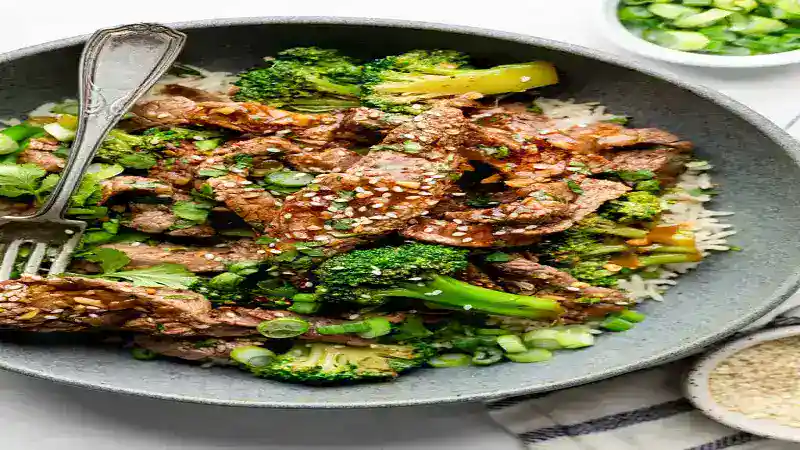
Beef and broccoli is a popular dish known for its savory flavors and satisfying textures. Made traditionally with delicate beef strips and crisp broccoli florets in a thick sauce, this dinner has earned a special place in the hearts of many. While delicious, it often contains more sodium, unhealthy fats, and calories. With some thoughtful adjustments, it can transform into a healthier option with all its original appeal and increased nutritional value. Here are five effective ways to improve this dish and make it a healthier meal without sacrificing flavor.
1. Choose Lean Cuts of Beef for Healthier Protein
Choosing lean cuts of beef is an important step toward making this dish healthier. Sirloin, flank, and tenderloin contain less fat than more marbled cuts like ribeye and T-bone. Apart from lowering the total saturated fat level, lean beef offers vital minerals like iron, zinc, and vitamin B. Cutting the beef against the grain into thin strips guarantees softness and helps the meat to cook fast and evenly while retaining moisture. Marinating beef in a concoction of low-sodium soy sauce, garlic, and ginger improves taste and helps tenderize it. This method creates a healthier version of the meal that yet satisfies the taste by lowering the need for excessive oils or heavy sauces.
2. Incorporate More Vegetables for Nutritional Boost
Beef and broccoli become a nutrient-dense dinner by adding more vegetables. With its abundance of vitamins C, K, and A, fiber, and antioxidants, broccoli is already a great option. Add vibrant veggies, like bell peppers, carrots, snap peas, or bok choy, to increase the health advantages. These ingredients improve the appearance of the meal and provide a spectrum of nutrients. Bell peppers, for example, boost vitamin C, which is essential for the immune system and skin health; carrots provide beta-carotene, which is good for eyesight. A rainbow of veggies helps to lower the total calorie density of the meal, which increases its filling power. This small modification not only enhances the taste but also helps the meal to be more balanced and nutrient-dense, therefore complementing a diet focused on health.
3. Opt for Whole Grains Instead of Refined Carbs
Traditionally, beef and broccoli are served over white rice or noodles, generally processed carbs devoid of fiber and other minerals. Choosing healthy grains like brown rice, quinoa, or whole wheat noodles greatly increases the dish’s fiber count, therefore improving its nutritional value. Richer in vitamins and minerals, these substitutes support improved digestive health and provide consistent energy. For nutritional fiber and a variety of B vitamins lost in white rice processing, brown rice, for example, has bran and germ. Quinoa is a great option for people who want to increase their protein intake in addition to their beef because it contains all nine essential amino acids, making it a complete protein.
4. Reduce Sodium with Flavorful Alternatives
Many beef and broccoli recipes use soy sauce or teriyaki sauce, which can be high in sodium and pose health risks like hypertension. Use low-sodium soy sauce or tamari to make a lower-sodium variation but still savor strong flavors. Including fresh herbs and spices also helps to improve the flavor of the meal without depending on salt. Along with improving the general flavor profile, ginger, garlic, and scallions have possible health advantages, including anti-inflammatory action. Another effective approach is to use citrus juice or zest, like lemon or lime, which provides brightness and acidity, thereby lowering the need for more salt.
5. Explore Healthy Cooking Methods for Better Nutrition
The healthiness of any cuisine relies significantly on the cooking technique. Often requiring large quantities of oil, traditional stir-frying may raise the fat and calorie count. Instead, think about steaming, sautéing with less oil, or air fryer cooking techniques. While maintaining nutrients lost after extended cooking, steaming broccoli keeps its vivid color and crunch. Just drizzling oil over high heat and sautéing the meat quickly helps it to brown wonderfully without turning it oily. Alternatively, using an air fryer can produce crispy beef without using much oil, making it a healthier option.
Conclusion
By making these five adjustments, beef and broccoli can be transformed into a healthier dish while maintaining their traditional appeal. Choosing lean cuts of beef, adding a range of vegetables, choosing whole grains, reducing sodium, and investigating effective cooking techniques help to create a well-balanced and nutritious meal. With careful planning, this beloved classic can meet dietary requirements without sacrificing flavor or satisfaction. A mindful beef and broccoli recipe not only pleases the palate but also improves overall health, making it an excellent choice for anyone looking to eat delicious and nutritious food.








